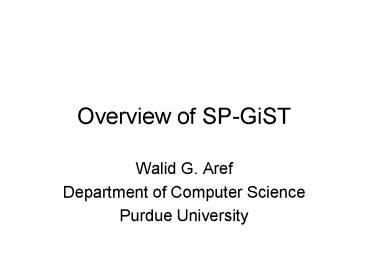Overview of SPGiST - PowerPoint PPT Presentation
1 / 17
Title:
Overview of SPGiST
Description:
... when to use the index and when not, cost model, selectivity estimation ... Integration with the query optimizer, costing, selectivity estimation. Node clustering ... – PowerPoint PPT presentation
Number of Views:105
Avg rating:3.0/5.0
Title: Overview of SPGiST
1
Overview of SP-GiST
- Walid G. Aref
- Department of Computer Science
- Purdue University
2
Indexing
- With the emergence of non-traditional database
applications, the need for non-traditional types
of indexes is inevitable - Example applications
3
Challenges in Indexing
- Current database systems support
- B-trees, hash tables
- Very few systems support R-trees
- Fewer systems support a variant of the region
quadtree
4
What is Wrong?
- Building and integrating an index type into the
database system is an overwhelming task - Integration with the query optimizer, when to use
the index and when not, cost model, selectivity
estimation - Providing query operators that utilize the index
- Concurrency control and recovery techniques
- Very few index structures/research address all
these issues
5
SP-GiST Space-partitioning Generalized Search
Trees
- Software engineering solution to support a wide
class of indexes inside a database management
system - GiST Supports B-tree-like indexes, e.g., R-trees
- SP-GiST Supports the class of space-partitioning
trees, e.g., variants of the quadtree, variants
of the trie, k-d tree
6
SP-GiST Space-partitioning Generalized Search
Trees
- The framework provides the basic services inside
a database system, e.g., - Concurrency control and recovery
- Query operators
- Bulk-loading and insertion
- Integration with the query optimizer, costing,
selectivity estimation - Node clustering
- SP-GiST supports the class of space-partitioning
(SP) trees - Suitable for emerging database applications
- An extensible index structure that can be
instantiated to realize any member in the class
of SP trees - Example index structures realizable by SP-GiST
- Disk-based versions of variants of the trie, all
variants of quadtrees and octrees, the k-d tree,
the bin-tree,
7
SP-GiST Extensible Interfaces
- Internal Methods
- Supported by the DBMS system
- reflect similarities among the various SP-trees,
e.g., insert, delete, search, bulk-load
algorithms - Interface Parameters and External Methods
- Extensible index interfaces
- Reflect structural and behavioral differences
among various SP-trees - Need to be supported by the user to instantiate a
new type of SP-tree index
8
Examples on SP Trees
Data Driven SP Trees Space is decomposed based
on the input data
Space Driven SP Trees Space decomposition is
independent from the order of data insertion
k-d Tree
Trie
9
Examples on Index Realization inside SP-GiST
10
Main Characteristics of Space-Partitioning Trees
- Decompose the space recursively into a fixed
number of disjoint partitions - There are two types of space-partitioning trees
- Space-driven space-partitioning trees
- e.g., the trie and region quadtree
- Data-driven space-partitioning trees
- e.g., the point quadtree and the k-d tree
11
Index Realization using SP-GiST
- Interface Parameters
- Key type Type of the data in the leaf-level of
the tree, - E.g., word, point
- Number of space partitions
- E.g., 4 for a quadtree, 26 for a trie, etc.
- Node predicate gives the predicate to use when
navigating the SP-tree - E.g., letter a, (x,y) inside node.rectangle
- Bucket size determines the maximum number of
items that a leaf node can hold
12
Index Realization using SP-GiST
- Resolution determines maximum number of space
decomposition, set based on the space and the
granularity required
13
Interface Parameters for SP-GiST
- PathShrink NeverShrink, LeafShrink, TreeShrink
14
Interface Parameters for SP-GiST
- NodeShrink Determines if empty partitions should
be kept in the tree or not - E.g., tree vs. forest
15
Index Realization using SP-GiST
- External Methods
- Consistent a boolean function to guide the
search in the tree - PickSplit defines the way for splitting nodes in
the tree - Cluster defines how tree nodes are clustered
into disk pages (SP-GiST provides a default
clustering algorithm)
16
SP-GiST Internal Methods
- Internal methods are provided by the SP-GiST
framework and does not need recoding - Search Traverses the tree using the Consistent
external method - Insert Delete Builds the tree using the
PickSplit and Cluster external methods - Bulk Load Uses a general bulk loading algorithm
ICDE 2004, Direct Buffering Bulk Loading
(DBDL), that can bulk load any SP-tree - Bulk Insert Uses a general bulk insertion
algorithm ICDE 2004, Buffer Tree Bulk Insertion
(BTBI) that can bulk insert a group of objects in
any SP-tree
17
SP-GiST Details
- More detail
- Ilyas and Aref, JIIS 2001, SSDBM 2001
- www.cs.purdue.edu/faculty/aref.html































